- The Timeline when the Bible was Written
- The Timeline of what Happened BEFORE the bible was written
Parts of the Hebrew Bible were written in perhaps the 10th century BCE. The final redaction and canonization of the Torah (the first five books of the Bible) most likely took place during the Babylonian Exile (6th–5th century BCE). The entire Hebrew Bible was complete by about 100 CE. The books of the New Testament were written in the 1st and 2nd centuries CE.
The first five books—Genesis, Exodus, Leviticus, book of Numbers and Deuteronomy—reached their present form in the Persian period (538–332 BC), and their authors were the elite of exilic returnees who controlled the Temple at that time. The books of Joshua, Judges, Samuel and Kings follow, forming a history of Israel from the Conquest of Canaan to the Siege of Jerusalem c. 587 BC. There is a broad consensus among scholars that these originated as a single work (the so-called "Deuteronomistic History") during the Babylonian exile of the 6th century BC.The two Books of Chronicles cover much the same material as the Pentateuch and Deuteronomistic history and probably date from the 4th century BC. Chronicles, and Ezra–Nehemiah, was probably finished during the 3rd century BC.[21] Catholic and Orthodox Old Testaments contain two (Catholic Old Testament) to four (Orthodox) Books of the Maccabees, written in the 2nd and 1st centuries BC.These history books make up around half the total content of the Old Testament. Of the remainder, the books of the various prophets—Isaiah, Jeremiah, Ezekiel, and the twelve "minor prophets"—were written between the 8th and 6th centuries BC, with the exceptions of Jonah and Daniel, which were written much later. The "wisdom" books—Job, Proverbs, Ecclesiastes, Psalms, Song of Songs—have various dates: Proverbs possibly was completed by the Hellenistic time (332–198 BC), though containing much older material as well; Job completed by the 6th century BC; Ecclesiastes by the 3rd century BC.
Wikipedia (article link) - Jericho has evidence of settlement dating back to 10,000 BCE. During the Younger Dryas [glaciation] period of cold and drought [sic, climate change], permanent habitation of any one location was impossible. However, the Ein es-Sultan spring at what would become Jericho was a popular camping ground for Natufian hunter-gatherer groups, who left a scattering of crescent-shaped microlith tools behind them. Around 9600 BCE, the droughts and cold of the Younger Dryas stadial had come to an end, making it possible for Natufian groups to extend the duration of their stay, eventually leading to year-round habitation and permanent settlement.
Wikipedia (article link) - The Neolithic or New Stone Age (from Greek νέος néos 'new' and λίθος líthos 'stone') is an archaeological period, the final division of the Stone Age in Europe, Asia and Africa. It saw the Neolithic Revolution, a wide-ranging set of developments that appear to have arisen independently in several parts of the world. This "Neolithic package" included the introduction of farming, domestication of animals, and change from a hunter-gatherer lifestyle to one of settlement. The term 'Neolithic' was coined by Sir John Lubbock in 1865 as a refinement of the three-age system.
The Neolithic began about 12,000 years ago when farming appeared in the Epipalaeolithic Near East, and later in other parts of the world. It lasted [until 4500 BC] in the Near East until the transitional period of the Chalcolithic (Copper Age) from about 6,500 years ago (sic, 4500 BC), marked by the development of metallurgy, leading up to the Bronze Age and Iron Age.
In other places, the Neolithic followed the Mesolithic (Middle Stone Age) and then lasted until later. In Ancient Egypt, the Neolithic lasted until the Protodynastic period, c. 3150 BC. In China, it lasted until circa 2000 BC with the rise of the pre-Shang Erlitou culture, and in Scandinavia, the Neolithic lasted until about 2000 BC.
When approaching the bible I was taught to never ask questions about dinosaurs or to look beyond the earliest Neolithic Ages before the Early Egyptian and Mesopotamian civilizations. This mindset stay in me for most of my life as I explored scientific discoveries (I have a math and science background), literature, history, economics, and so forth, while raising a family, running a very small single-owner business, holding multiple lay ministries, and being active in several sports year round over decades.
When becoming an "empty nester" (sic, no kids living with us) and later retiring early at 53, I found myself motivated to write poetry and then later, to develop a new theology due to my poetry (I found my Westernized philosophic foundations out of date and creaky). I began writing poetry in 2009 and theology about 3 years later in 2011. To help me I taught myself to use Google blogger and established two sites, one for poetry and one for theology.
My motivation was to share all which I had been taught to overlook and never ask about. But then again, perhaps this was also my perceived boundaries. Which later proved true as my Christian friends did not wish to speak about my new interests and eschewed anything pertaining to social justice, the environment (I spent 15 active retirement years in quasi-political ecological reform in my area), women's equality, multi-ethnic pluralism, intersectional theology, minority rights, or newer bible perspectives and theologies than their own traditional backgrounds. So, I found myself with very few, if any supporters, encouragers, and curious fellowships except those I read on the Internet.
But by utilizing the forbidden activity of "doubt and uncertainty" and by following the Holy Spirit I now have been wandering about for these 12 years beyond my heavily-defined evangelical borders. Personally, I am far less burdened by having undertaken this difficult journey away from my religious ancestry. The articles I post here I hope will be a helpful directional guides to any forward movements amongst today's church which might be positive, curious, and loving in all directional activities.- R.E. Slater
Some say miracles are all around us. This is true and undeniable. But others wisely say, "Be the miracle to those needing miracles." This is all the difference in a Christian faith utilizing the miracles it has been given to it by the Spirit of God. - re slater
Ps... I purposely avoided the word "GOD made" as the preferred word used by the church. Rather I use the word "GOD formed". In one of my more recent posted articles I explain why. From a process scientific outlook, there has to be something from which God formed creation. God cannot form something from nothing. That is, something cannot come from nothing, given the kind of universe we live in. To this point, I have many articles on this subject. Simply look them up on the site here.
 |
| chart link |
* * * * * * *
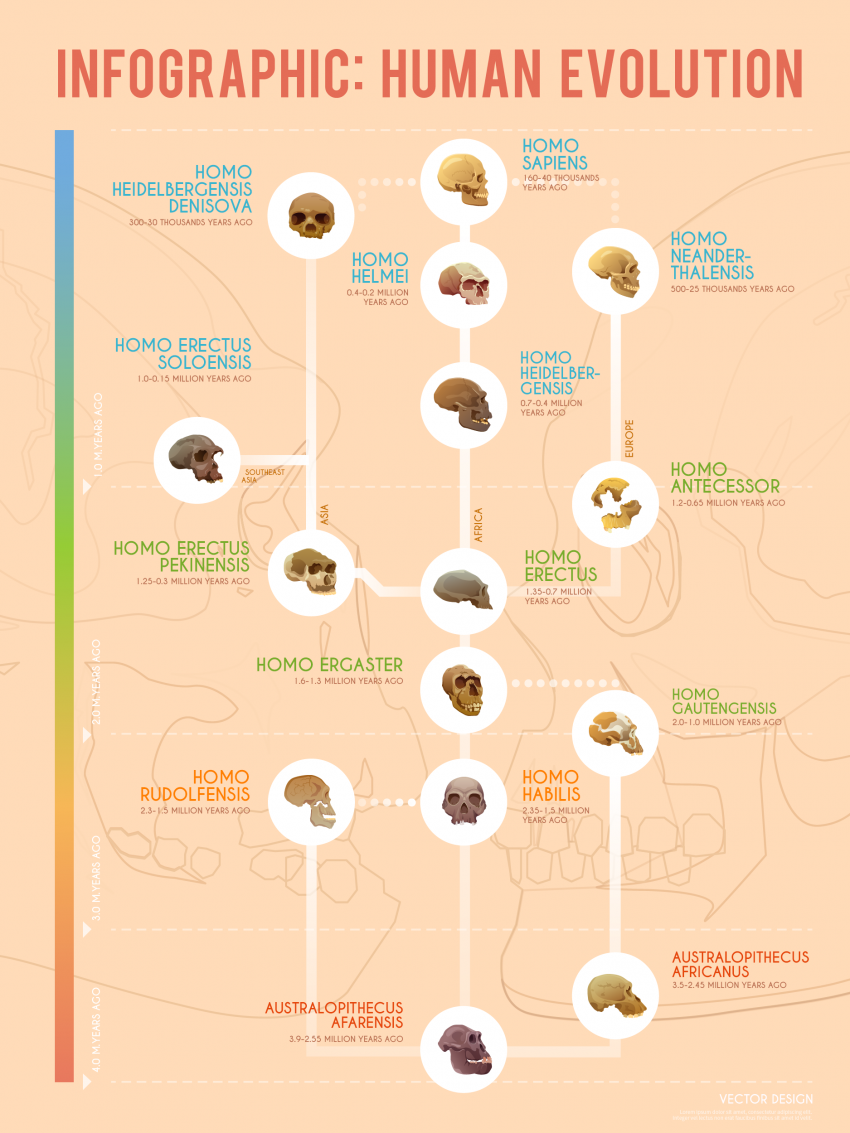
1. AUSTRALOPITHECUS AFARENSIS
Australopithecus Afarensis was the earliest form of hominids, which archaeologists dug up fossils in the Afar Triangle of Africa, hence the name “Afarensis”.

- Australopithecus afarensis is an extinct hominin species that lived approximately 3.9 to 2.9 million years ago during the Pliocene and early Pleistocene epochs.
- They are believed to be among the earliest hominins, with a mixture of ape-like and human-like features.
- The most famous individual of this species is “Lucy,” a nearly complete skeleton discovered in Ethiopia in 1974.
- Australopithecus afarensis had a small brain relative to modern humans, indicating limited cognitive abilities.
- They were bipedal, walking on two legs, which is a significant adaptation in hominin evolution.
- The species likely lived in wooded environments and had a diverse diet, including both plant and animal-based foods.
- Australopithecus afarensis individuals were relatively small in stature, with males and females exhibiting sexual dimorphism in body size.
- Fossil evidence suggests they used tools, but their tool-making capabilities were limited compared to later hominin species.
2. AUSTRALOPITHECUS AFRICANUS
Australopithecus Africanus is the first of the early ape species classified as hominids.
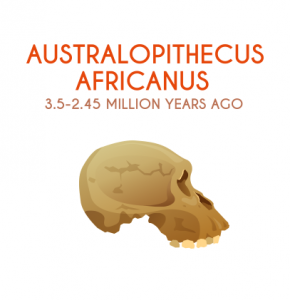
- Australopithecus africanus is an extinct hominin species that lived between 3.5 and 2.4 million years ago in Southern Africa during the Pliocene and Pleistocene epochs.
- It is known for being one of the first hominins to be discovered and described from Africa.
- Australopithecus africanus had a combination of ape-like and human-like features, such as a small brain size relative to modern humans and a bipedal upright posture.
- These hominins likely lived in woodlands and grasslands, which influenced their diet, consisting of both plant and animal foods.
- Although they were not advanced tool users, they may have used simple tools, such as rocks and sticks, for various purposes.
- Australopithecus africanus individuals had a facial structure that resembled apes more closely than modern humans, with a projecting face and pronounced brow ridges.
3. HOMO HABILIS
About 2.35 – 1.5 million years ago, Homo Habilis had larger brains which helped their survival.
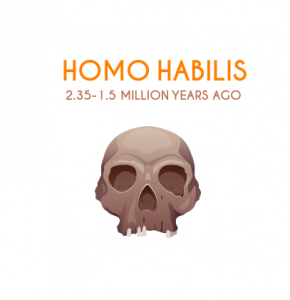
- Homo habilis, which means “handy man,” is an extinct species of early humans that lived approximately 2.4 to 1.4 million years ago during the early Pleistocene epoch.
- They were among the first members of the Homo genus and are considered one of our direct ancestors.
- Homo habilis exhibited significant advancements compared to earlier hominins, including the use of tools, which is reflected in their nickname.
- The Olduvai Gorge in Tanzania is a significant archaeological site where many Homo habilis fossils and stone tools have been discovered.
- Their brain size was larger than that of earlier hominins but still smaller than modern humans, suggesting some cognitive development.
- Homo habilis had a more upright posture and a bipedal gait, allowing them to walk on two legs efficiently.
- Their diet likely consisted of a variety of foods, including plant materials and scavenged or hunted animals.
- The species played a crucial role in the transition from australopithecines to more advanced Homo species like Homo erectus.
- While they primarily used simple stone tools, their ability to fashion and use tools marked a significant milestone in human evolution.
4. HOMO RUDOLFENSIS
Homo Rudolfensis is an extinct hominin species that lived during the Pliocene and Pleistocene epochs, around 2.4 million years ago.
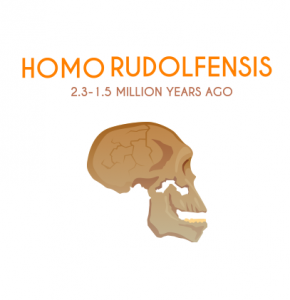
- This species is known from fossil remains discovered near Lake Turkana in Kenya, specifically at Koobi Fora.
- The exact classification of Homo Rudolfensis is debated, and some researchers consider it a distinct species, while others propose it may be a variation of Homo habilis.
- Fossil evidence of Homo Rudolfensis includes a relatively large and rounded braincase, indicating a larger brain size compared to earlier hominins.
- They exhibited a more human-like facial structure and dental characteristics, but the overall body size and limb proportions were still primitive.
- Homo Rudolfensis is associated with the use of simple stone tools, suggesting some level of toolmaking and tool use.
5. HOMO GAUTENGENSIS
Homo Gautengensis is a proposed hominin species that is not widely accepted by the scientific community.

- It is hypothesized Homo Gautengensis to have lived around 2 million years ago in South Africa.
- Fossil evidence for this species is sparse and contentious, making it difficult to establish its place in human evolutionary history.
- Some researchers suggest that Homo Gautengensis may represent a regional variation or a subgroup within the broader category of early Homo.
- Like other early Homo species, it likely had a relatively small brain size compared to modern humans but exhibited some adaptations associated with bipedalism.
- Homo Gautengensis had big teeth for chewing plants, consumed more vegetables, and likely had smaller brains.
- They also may have used fire and stone tools.
6. HOMO ERGASTER
Homo Ergaster is an extinct hominin species that lived approximately 1.6 to 1.3 million years ago during the early Pleistocene epoch.

- The nickname for Homo Ergaster is “Workingman” because they built more sophisticated stone tools (archaeologists often discovered hand-axes and cleavers near skeletons found).
- Fossil evidence for Homo Ergaster is primarily associated with sites in Africa, such as Koobi Fora in Kenya and Dmanisi in Georgia.
- They are considered one of the early members of the Homo genus and represent an important transitional species between earlier hominins like Homo habilis and later ones like Homo erectus.
- Homo Ergaster is known for its more modern and human-like characteristics, including a relatively larger brain size and a more developed body structure for endurance running.
- They exhibited a pronounced reduction in facial prognathism (forward projection of the face) compared to earlier hominins.
- Homo Ergaster is associated with the Acheulean stone tool industry, characterized by the creation of bifacial handaxes and cleavers.
- Their hunting and scavenging abilities, along with the use of fire, likely played a crucial role in their survival and expansion.
7. HOMO ERECTUS
Homo Erectus lived approximately 1.3 million to 0.7 years ago and was found along the southern coast of Asia.

- They are considered one of the first hominin species to have expanded out of Africa and colonized different parts of the world.
- Fossil evidence for Homo Erectus has been found in various locations, including Africa, Asia, and Indonesia.
- Homo Erectus is characterized by a more modern and human-like anatomy compared to earlier hominins. They had a larger brain size because they were believed to eat more meat.
- They are believed to have been the first hominin species to use fire deliberately, which had significant implications for cooking, warmth, and protection.
- Homo Erectus is considered a crucial transitional species in human evolution, bridging the gap between earlier hominins and anatomically modern humans.
- Their migration out of Africa is a significant milestone in human prehistory, leading to the colonization of different regions and adaptation to diverse environments.
8. HOMO ERECTUS PEKINESIS
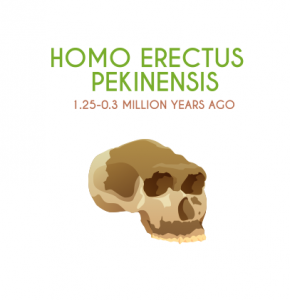
Homo Erectus Pekinesis existed 1.25 – 0.3 million years ago and their fossils were mostly found near Beijing (Peking).
- Homo Erectus Pekinensis is a subspecies of Homo erectus and is best known for the discovery of fossils in Zhoukoudian (Choukoutien), near Beijing, China.
- Fossils of Peking Man were discovered in the 1920s and 1930s and played a significant role in our understanding of human evolution.
- They are associated with the use of tools and evidence of fire use, suggesting advanced cognitive and cultural abilities.
- They are known as “Peking Man” because these fossils were mostly found near Beijing (Peking).
- These extinct hominids were known to have heavy brow ridges and the use of stone tools.
- The study of Peking Man contributed to our understanding of hominin dispersal and adaptation to different environments, particularly in East Asia.
9. HOMO ANTECESSOR
Homo Antecessor is recognized as “Human Pioneer” due to the belief they belonged to the first human population in Europe.
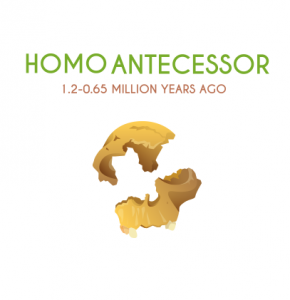
- Homo Antecessor is an extinct hominin species that lived during the Lower Pleistocene epoch, approximately 1.2 million to 650,000 years ago.
- Fossil evidence for Homo Antecessor was discovered at the Gran Dolina site in Atapuerca, Spain, and at other locations in Europe.
- The name “antecessor” means “pioneer” or “ancestor” in Latin, reflecting its position as a possible common ancestor to both Neanderthals and modern humans.
- This species is characterized by a combination of primitive and more advanced features. It had a relatively small brain size but showed evidence of tool use and possibly meat consumption.
- The discovery of cut marks on animal bones at the Atapuerca site suggests that Homo Antecessor was involved in butchery and hunting activities.
- Some researchers suggest that Homo Antecessor may have been one of the first hominins to inhabit Europe, making it an important part of the continent’s prehistory.
10. HOMO ERECTUS SOLENSIS
About 1.0 – 0.15 million years ago, scientists discovered this type of hominid in Indonesia on the island of Java.
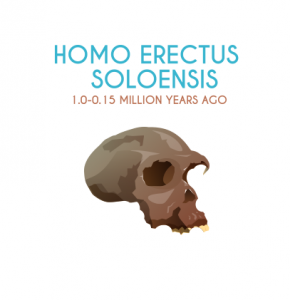
- Homo Erectus Soloensis is a subspecies of Homo Erectus known from fossil remains found in the Solo River region of Java, Indonesia.
- These fossils were discovered in the 1930s and are sometimes referred to as “Solo Man” or “Ngandong Man” after the nearby Ngandong village.
- Homo erectus soloensis is estimated to have lived around 150,000 to 1,000,000 years ago during the Middle and Late Pleistocene.
- The fossils include skullcaps, teeth, and other skeletal elements, providing insights into the anatomy of this subspecies.
- Like other Homo erectus populations, Homo erectus soloensis is characterized by a relatively large brain size compared to earlier hominins.
- They are associated with the use of Acheulean stone tools, which are more advanced than the tools used by earlier hominins.
- Evidence of fire use has also been found at some sites, suggesting an ability to control and control fire.
11. HOMO HEIDELBERGENSIS
About 0.7-0.4 million years ago, Homo Heidelbergensis existed in both Africa and Europe. But archaeologists found fossils of Homo Heidelbergensis near Heidelberg Germany (hence the name).

- Homo Heidelbergensis is an extinct hominin species that lived during the Middle Pleistocene period, approximately 700,000 to 400,000 years ago.
- Fossil evidence for Homo heidelbergensis has been found at various sites across Africa, Europe, and possibly Asia, indicating a wide geographic distribution.
- This species exhibits a mix of primitive and more advanced anatomical features. They had a larger brain size compared to earlier hominins, suggesting increased cognitive abilities.
- Homo Heidelbergensis is associated with the development of more sophisticated stone tools, including handaxes and cleavers, which are characteristic of the Acheulean industry.
- Some researchers believe they are most notable for possibly burying their dead.
- They were likely skilled hunters and gatherers, capable of using fire and building simple shelters.
- The species demonstrates adaptations to various environments, from temperate regions in Europe to more tropical climates in Africa.12. Homo Helmei
12. HOMO HELMEI
There is uncertainty about Homo Helmei compared to other hominin species. About 0.4 – 0.2 million years ago, Homo Helmei existed only for a short period of time.
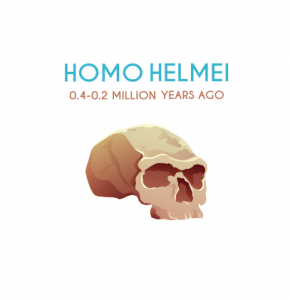
- Homo Helmei is theorized to have displayed a unique combination of physical traits, blending features from different known hominin species.
- Although they are a speculative hominin species, researchers propose they are known for their out-of-Africa movement and that their brain volume is slightly larger than modern humans.
- Research is still being developed to improve our understanding of Homo Helmei.
13. HOMO NEANDERTHALENSIS
Homo Neanderthalensis, or Neanderthals, is an extinct species of hominins closely related to modern humans (Homo sapiens).
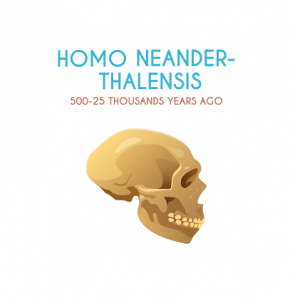
- Neanderthals lived in Eurasia and Africa from approximately 500,000 to 25,000 years ago.
- They had a robust build with stocky bodies, adapted for cold climates.
- Prominent features included a large brow ridge, strong jaw, and a wide nose.
- Evidence suggests they had the ability to speak and may have used complex language.
- Neanderthals were skilled hunters and gatherers, using tools such as spears and handaxes.
- They lived in small, close-knit groups and had social structures.
- Evidence of burial practices suggests a degree of ritual and symbolic behavior.
- Studies have shown that some modern humans of non-African descent carry small percentages of Neanderthal DNA, indicating limited interbreeding between the two species.
14. HOMO SAPIENS
About 160-40 thousand years ago, the “doubly wise man” was the recent form of modern humans “homo sapiens sapiens”.

- Homo sapiens is the only surviving species in the Homo genus and the only extant hominin species.
- Homo sapiens were known for their artistic talents in cave paintings and clay work.
- They made hooks and spears to catch fish and invented the spear thrower. Thus, it made them better hunters because they could hunt from a distance.
- They have a high forehead, less prominent brow ridges, a rounded skull, and a vertical face. Modern humans have a complex vocal apparatus that allows for advanced language and communication.
- Homo sapiens coexisted with other hominin species, including Neanderthals and Denisovans, for some time.
Homo sapiens is the only surviving hominin species, and their success is attributed to their unique combination of cognitive abilities, culture, and adaptability, which allowed them to thrive and become the dominant species on Earth.
A Timeline of Human Evolution
Since about 4 million years ago, humans have evolved from early hominids to modern humans. Here are 14 species examples from human evolution now extinct.
Apes remained in trees as their primary food source. Eventually, grass began to spread in places like the African Savannah. Because there were fewer trees, this forced apes to walk to new food sources.
With their heads above the grass to see predators, apes evolved by walking on two legs. It also helped to have their hands available when they were traveling. So here we are at this point in human evolution.
Do you have any general questions about the theory of evolution? Please send us your comments and questions below.











